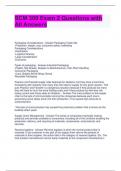SCM 300 Exam 2 Questions with
All Answers
Packaging Considerations - Answer-Packaging Trade-offs
-Protection, weight, cost, consumer safety, marketing
Packaging Considerations
-Destination
-Logistics Itinerary
-Legal Consideration
-Economic
Types of packaging - Answer-Industrial Packaging
-Pallets, Slip Sheets, Supplier to Manbufacturer, Inter-Plant Handling
Consumer Packaging
-Cans, Bottles Shrink Wrap, Boxes
Reusable Packaging
Pearson and Fawcett supply roller bearings for Grebson, but they have a hard time
forecasting with certainty how many they will need to supply for any given quarter. This
puts Pearson and Fawcett in a dangerous situation because if they produce too many
they will have to incur the extra holding costs and if they produce too few they risk
losing current and future sales to Grebson. - Answer-The main problem in this supply
chain is the lack of communication among the companies because each one is
accounting some safety stock into their production. This causes high amounts of
overproduction.
This lack of communication has caused the production problem that is known as the
bullwhip effect (each
Supply Chain Management - Answer-The series of companies eventually making
products and services available to consumers, including all of the functions enabling the
production, delivery, and recycling of materials, components, end products, and
services.
Reverse logistics - Answer-Reverse logistics is when the normal product flow is
reversed. If any customer in any part of the supply chain returns the product or
materials to their supplier, the action falls in the category of reverse logistics. (Ex. The
final product manufacturer returns faulty materials to the component manufacturer.).
, Procuremen - Answer-The process of obtaining services, supplies, and equipment in
conformation with corporate regulations. Responsibilities include supplier selection,
purchasing negotiations, supplier relationship management, and materials/inventory
management.
• 3 flows - Answer-Procurement, Operations and Logistics and The end result of the
product
Procurement - Answer-The first part of the supply chain. Deals with materials and
inventory management
Operations and Logistics - Answer-Adds value to the product and transports it to
customers
The end result of the product - Answer-a. Product/services: Emphasis on cost, quality,
speed, and flexibility.
b. Waste: Non-valuable outputs, defects, garbage, emissions, resource waste
Supply chain visibility - Answer-The ability to communicate with and continually assess
the entire supply chain.
• Seven types of organizational waste - Answer-defects, overproduction, transportation,
motion, waiting, inventory and over-processing
Defects - Answer-Obvious, but could cause additional waste
Overproduction - Answer-Production used to mask shortcomings
Transportation - Answer-No value added, Possible loss
Motion - Answer-Employee and Machines
Waiting - Answer-Resources are wasted during waiting
Lawn mowers are sold mostly in the summer months but are manufactured around the
year to meet the heavy
summer demand. What category of inventory would this exemplify? - Answer-
anticipation inventory
When there is a lack of suitable suppliers, firms may assist existing suppliers to improve
their overall output
and capabilities. This growing trend by firms is referred to as... - Answer-supplier
development
According to the lecture, Cost, Quality, Speed, and Flexibility are referred to as... -
Answer-competitive priorities




